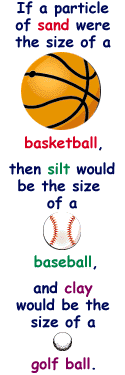|

Soil Types
People describe soil types in all kinds of ways such as
heavy, light, sandy, clay, loam, poor or good. Soil scientists
describe soil types by how much sand, silt and clay are
present. This is called texture.
It is possible to change the texture by adding different
things. Changing texture can help in providing the right
conditions needed for plant growth.
Sand
is the largest particle in the soil. When you rub it, it
feels rough. This is because it has sharp edges. Sand doesn't
hold many nutrients.
Silt
is a soil particle whose size is between sand and clay.
Silt feels smooth and powdery. When wet it feels smooth
but not sticky.
Clay
is the smallest of particles. Clay is smooth when dry and
sticky when wet. Soils high in clay content are called heavy
soils. Clay also can hold a lot of nutrients, but doesn't
let air and water through it well.
 Particle
size has a lot to do with a soil's drainage and nutrient
holding capacity. To better understand how big these three
soil particles are, think of them like this. If a particle
of sand were the size of a basketball, then silt would be
the size of a baseball, and clay would be the size of a
golf ball. Line them all up, and you can see how these particles
compare in size. Particle
size has a lot to do with a soil's drainage and nutrient
holding capacity. To better understand how big these three
soil particles are, think of them like this. If a particle
of sand were the size of a basketball, then silt would be
the size of a baseball, and clay would be the size of a
golf ball. Line them all up, and you can see how these particles
compare in size.
Did you get all that?
Test what you know by solving Mystery #1.
|



